THUNDER BAY - As several large forest fires continue to burn in Northern Alberta, fire crews from across the region will be lending a hand as the fire hazard throughout most Northern Ontario remains low.
Approximately 60 Ministry of Natural Resources and Forestry firefighters and 19 incident management personnel from fire bases across Northern Ontario including Sudbury, Timmins, North Bay, Cochrane, Thunder Bay, Dryden, Sioux Lookout, Red Lake, and Armstrong are flying to Edmonton on Friday.
“We don’t know a lot about what we are going to or what we are getting into, we just know we are going out to help,” said Gary Harland, fire management supervisor with the MNRF in Thunder Bay, who is also travelling to Edmonton with his incident management team.
There are several large forest fires burning out of control in Northern Alberta, including a 92,000-hectare blaze south of High Level, which has forced more than 1,000 people to evacuate.
According to Len Sedore with the MNRF and local president of Ontario Public Service Employees Union Local 623, fire crews will be based out of Edmonton.
“They will get a briefing and be dispatched to where they are needed,” he said. “It sounds like High Level is where they need them, but they could go anywhere. Wherever they need them they will send them.”
The tour is expected to take no more than 19 days, as fire crews can only spend a maximum of 14 days on a fire line. Those selected to go are returning from days off to ensure they are fresh and rested.
Sedore said it is not known at this time if more tours will be sent but it is likely given the conditions in Northern Alberta.
“It will be based on need,” he said. “They will anticipate there will be other crews going out to backfill when these go out. It’s not going to end quickly.”
Luckily, wet and cold conditions in much of the Northwest has meant a slow start to the 2019 fire season compared to the warm and dry May last year.
“The south half of the region has had precipitation and cooler weather like we’ve experienced here in Thunder Bay so the hazard is low at this time,” Harland said. “North Red Lake, Sioux Lookout has a moderate to high hazard, so there is still concern up there.”
Harland added that the region is still under spring conditions, which can change very quickly.
“As long as the brown grass lingers and the trees haven’t flushed and not in full leaf, the fire hazard changes very quickly and one good drying day and we have a hazard again,” he said. “At least until the brown grass is superseded by green grass.”
As for what the fire season has in store for the region in the summer months, Harland said he doesn’t bother trying to make predictions anymore.
“It changes so fast,” he said. “I’ve been at this for 35 or 36 years now and I’ve seen huge winters of snow followed by amazing fire seasons and really wet springs followed by crazy fire seasons and really dry springs followed by really wet summers.”
If conditions change in the region and the hazard peaks, Harland said any out of province commitments would have to be reduced. But luckily wet weather and below normal temperatures remain in the forecast for much of the region, allowing MNRF crews to assist other areas in need.
“We really count on the other provinces when we get busy,” Harland said. “No jurisdiction has enough firefighters and equipment to handle worst case scenarios. Last year when we were busy, firefighters from several provinces came to help us. So it’s important we carry on that relationship and support them when we are wet here.”
